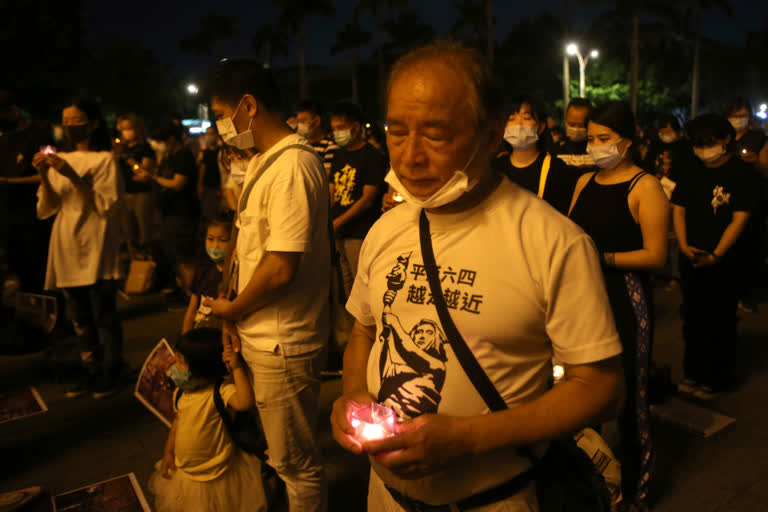Hong Kong: Thousands of people in Hong Kong defied a police ban Thursday evening, breaking through barricades to hold a candlelight vigil on the 31st anniversary of China's crushing of a democracy movement centred on Beijing’s Tiananmen Square.
With democracy snuffed out in the mainland, the focus has shifted increasingly to semi-autonomous Hong Kong, where authorities for the first time banned the annual vigil that remembers victims of the 1989 crackdown.
Beijing is taking a tougher stance following months of anti-government protests last year, in what activists see as an accelerating erosion of the city’s rights and liberties. Earlier Thursday, the Hong Kong legislature passed a law making it a crime to disrespect China’s national anthem. Pro-democracy lawmakers had disrupted proceedings to try to prevent the vote.
Despite the police ban, crowds poured into Victoria Park to light candles and observe a minute of silence at 8:09 pm (1209 GMT, 8:09 am EDT). Many chanted “Democracy now” and “Stand for freedom, stand with Hong Kong.”
While police played recordings warning people not to participate in the unauthorized gathering, they did little to stop people from entering the park. Authorities had cited the need for social distancing during the coronavirus pandemic in barricading the sprawling park, but activists saw the outbreak as a convenient excuse.
"If we don’t come out today, we don’t even know if we can still come out next year,” said participant Serena Cheung.
Police said they made arrests in the city's Mongkok district, where large crowds also rallied. When several protesters tried to block a road, officers rushed to detain them, using pepper spray and raising a blue flag to warn them to disperse or they would use force on the unauthorized gathering. On Twitter, they urged people not to gather in groups because of the coronavirus.
After the vigil ended in Victoria Park, groups of protesters dressed in black carried flags that said, “Liberate Hong Kong, Revolution of our times” as well as “Hong Kong Independence.”
Read more:Pro-HKong students protest China security law
Hundreds and possibly thousands of people were killed when tanks and troops moved in on Tiananmen Square the night of June 3-4, 1989, to break up weeks of student-led protests that had spread to other cities and were seen as a threat to Communist Party rule.
A Chinese foreign ministry spokesperson offered the government’s standard defense of the 1989 crackdown.
“The Chinese government has made a clear conclusion about the political disturbance that occurred in the late 1980s,” Zhao Lijian said. “The great achievements that we have achieved ... have fully demonstrated that the development path China has chosen is completely correct, which conforms to China’s national conditions and has won the sincere support of the Chinese people.”
On Thursday, the square where thousands of students had gathered in 1989 was quiet and largely empty. Police and armoured vehicles stood guard on the vast space. Few pedestrians lined up at security checkpoints, where they had to show IDs to be allowed through as part of nationwide mass surveillance to prevent any commemoration of the event.
As has become customary, many dissidents were placed under house arrest and their communications with the outside world cut off, according to rights groups.
“We all know the Hong Kong government and the Chinese government really don’t want to see the candle lights in Victoria Park,” said Wu’er Kaixi, a former student leader who was No. 2 on the government’s most-wanted list following the Tiananmen Square crackdown.
“The Chinese Communists want us all to forget about what happened 31 years ago," he told The Associated Press in Taiwan, where he lives. "But it is the Chinese government themselves reminding the whole world that they are the same government ... doing the same in Hong Kong.”
